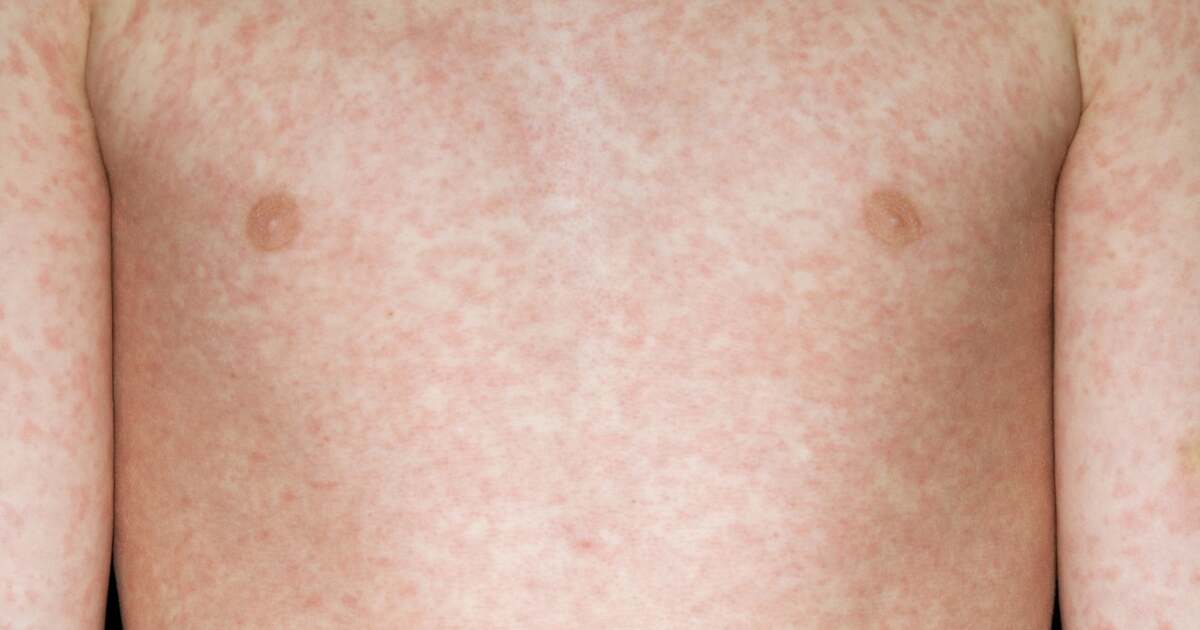The transmission route of the disease is respiratory, through droplets of saliva, sneezing or coughing. Infectiousness is very high, as approximately 95% of previously unimmunized people will develop the disease. From a clinical point of view, about 10-12 days pass from when a person contracts the virus to when it manifests itself. The clinical manifestation period is characterized by fever, chills, headache and body aches, accompanied by a state of exhaustion, and other symptoms such as:
- rhinorrhea (runny nose)
- odynophagia (pain on swallowing)
- dysphonia (hoarseness – change in the quality of the voice)
- cough
- bilateral conjunctivitis, which gives the baby a “watery” appearance.
- nausea
- He retched
- diarrhea
A few days before the appearance of the rash, Koplick’s sign appears, typical of measles and consisting of the appearance of small whitish lesions (similar to grains of semolina), located on the inside of the cheek, near the premolars. At the same time, doctors say that neurological manifestations and even irritability states can be observed.
On the first day of illness, the rash appears on the face and neck, on the second day it spreads to the trunk, and on the third day it affects the hands and feet. The rash in this case is in the form of erythema.
Measles in adults can be more severe than in children and is more commonly associated with pneumonia and liver damage. Measles in pregnant women, if it occurs in the first 3 months of pregnancy, can sometimes cause birth defects, miscarriage or fetal death in the womb, but also a high risk of developing measles pneumonia. Measles in the immunocompromised has an extremely severe, often fatal course.
“The complications of measles are multiple and can be determined directly by the measles virus or by the immunosuppressed condition of the patient as follows: measles interstitial pneumonia; laryngitis; acute meningitis, acute measles encephalitis during measles infection and acute post-measles encephalitis, occurring in the first 30 days after measles; encephalitis with inclusions, which occurs in immunocompromised children in the first year after measles or bacterial superinfections,” says Aneta Goia, resident physician in Infectious Diseases at the “Victor Babeș” hospital in Timișoara.
In addition, the patient should be isolated for 5 days after the onset of the rash and contacts should be monitored.
Treatment
There is no specific therapy for measles, so one is used for the symptoms. Cortisone therapy, associated with standard immunoglobulins, is recommended in acute post-traumatic encephalitis. Antibiotic treatment is recommended in case of bacterial superinfection.
The most useful prevention is the measles vaccination, which is part of the national vaccination program in Romania and is represented by a live attenuated virus vaccine that provides 90-95% protection. The first dose is given around the age of 1, followed by a booster at the age of 6-7 (at school entrance). Measles vaccination used within the first 72 hours after contact with a patient with measles can prevent the onset of the disease or lead to a mild form of the disease. The vaccine is contraindicated during pregnancy and in immunosuppressed patients, explains Dr. Aneta Goia.


![[월드컵] “Discord rumors” Ronaldo and Fernands train together… Portugal as a whole [월드컵] “Discord rumors” Ronaldo and Fernands train together… Portugal as a whole](https://img9.yna.co.kr/photo/etc/af/2022/11/20/PAF20221120173701009_P4.jpg)